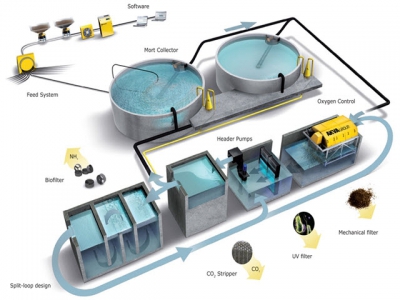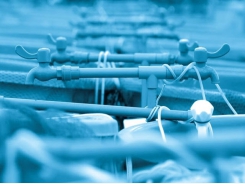A Guide to Recirculation Aquaculture - Part 6

Chapter 3: Fish species in recirculation
A recirculation system is a costly affair to build and to operate. There is competition on markets for fish and production must be efficient in order to make a profit. Selecting the right species to produce and constructing a well functioning system are therefore of high importance. Essentially, the aim is to sell the fish at a high price and at the same time keep the production cost at the lowest possible level.
Water temperature is one of the most important parameters when looking at the feasibility of fish farming, because fish are cold blooded animals. This means that fish have the same body temperature as the temperature of the surrounding water. Fish cannot regulate their body temperature like pigs, cows or other farmed animals. Fish simply do not grow well when the water is cold; the warmer the water, the better the growth. Different species have different growth rates depending on the water temperature, and fish also have upper and lower lethal temperature limits. The farmer must be sure to keep his stock within these limits or the fish will die.

Figure 3.1 Growth rate of rainbow trout at 6 degrees and at 16 degrees Celsius as function of fish size.
Another issue affecting the feasibility of fish farming is the size of the fish grown in the farm. At any given temperature, small fish have a higher growth rate than large fish. This means that small fish are able to gain more weight over the same period of time than large fish – see figure 3.1.
Small fish also convert fish feed at a better rate than large fish - see figure 3.2. Growing faster and utilising feed more efficiently will of course have a positive influence on the production costs as these are lowered when calculated per kilo of fish produced. However, the production of small fish is just one step in the whole production process through to marketable fish. Naturally, not all fish produced in fish farming can be small fish, and the potential for growing small fish is therefore limited. Nevertheless, when discussing what kind of fish to produce in recirculation systems, the answer, first and foremost, will be small fish. It simply makes sense to invest money in fry production, because you get more out of your investment when farming small fish.
The cost of reaching and maintaining the optimal water temperature all year round in a recirculation facility is money well spent. Keeping fish at optimal rearing conditions will give a much higher growth rate in comparison to the often sub-optimal conditions in the wild. Also, it is important to note that all the advantages of clean water, sufficient oxygen levels, etc. in a recirculation system have a positive effect on survival rate, fish health, etc., which in the end gives a high quality product.

Figure 3.2 Feed conversion rate (FCR) of rainbow trout in a recirculation system, related to fish weight at 15-18 degrees Celsius.
Compared to other farmed animals there is a large variety of fish, and many different fish species are farmed. In comparison, the market for pigs, cattle or chicken is not diversified in the same way as fish. The consumer does not ask for different species of pigs, cattle or chicken, they just ask for different cuts or sizes of cuts. But when it comes to fish, the choice of species is wide, and the consumer is used to choosing from a range of different fish, a situation which makes many different fish species interesting in the eyes of any fish farmer. Over the past decade some hundred aquatic species have been introduced to aquaculture and the rate of domestication of aquatic species is around hundred times faster than that of the domestication of plants and animals on land.
Looking at the world production volume of farmed fish, the picture is not in favour of a multi species output. From figure 3.3 it can be seen that carp, of which we are only talking of some 5 different sub-species, is by far the most dominant. Salmon and trout are next in line, and this is only two species. The rest amounts to some ten species. One therefore has to realise that although there are plenty of species to be cultured, only a few of these go on to become real successes on a world-wide scale. However, this does not mean that all the new fish species introduced to aquaculture are failures. One just has to realise that the world production volume of new species is limited, and that the success and failures of growing these species depend very much on market conditions. Producing a small volume of a prestigious fish species may well be profitable as it fetches a high price. However, because the market for prestigious species is limited, the price may soon go down if production and thereby availability of the product rises. It can be very profitable to be the first and only one on the market with a new species in aquaculture. On the other hand, it is also a risky business with a high degree of uncertainty in both production and in market development.

Figure 3.3 Distribution of global farmed seafood production in 2013. Source: FAO
When introducing new species in aquaculture it should also be remembered that it is wild species, which are being captured and tested in aquaculture. Domestication is most often a long and troublesome task. There are many impacts, which will influence growth performance, such as high genetic variation in growth rate, feed conversation rate, survival rate and problems with early maturation and disease susceptibility. Thus it is very likely that the performance of fish from the wild does not correspond to the expectations of the aquaculturist. Also, viruses in wild stocks can be brought in, of which some only appear after several years breeding, resulting in a demoralising experience.
To give general recommendations on which species to culture in recirculation systems is not an easy task. Many factors influence the success of a fish farming business. For example, local building costs, cost and stability of electricity supply, availability of skilled personnel, etc. Two important questions though should be asked before anything else is discussed: does the fish species being considered have the ability to perform well in a recirculation facility; and secondly is there a market for this species that will fetch a price high enough and at volumes large enough to make the project profitable.
The first question can be answered in a relatively simple manner: seen from a biological point of view, any type of fish reared successfully in traditional aquaculture can just as easily be reared in recirculation. As mentioned, the environment inside the recirculated fish farm can be adjusted to match the exact needs of the species reared. The recirculation technology in itself is not an obstacle to any new species introduced. The fish will grow just as well, and often even better, in a recirculation unit. Whether it will perform well from an economic point of view is more uncertain as this depends on the market conditions, the investment and the production costs and the ability of the species to grow rapidly. Rearing fish with generally low growth rates, such as extreme cold water species, makes it difficult to produce a yearly output that justifies the investment made in the facility.
Whether market conditions are favourable for a given species reared in a recirculation system depends highly on competition from other producers. And this is not restricted to local producers; fish trading is a global business and competition is global too. Trout farmed in Poland may well have to compete with catfish from Vietnam or salmon from farms in Norway as fish are easily distributed around the world at low cost.
It has always been recommended to use recirculation systems to produce expensive fish, because a high selling price leaves room for higher production costs. A good example is the eel farming business where a high selling price allows relatively high production costs. On the other hand, there is a strong tendency to use recirculation systems also for lower priced fish species such as trout or salmon.
The Danish recirculation trout farm concept is a good example of recirculation systems entering a relatively low price segment such as portion sized trout. However, it is necessary for such production systems to be huge, operating in volumes from 1 000 tonnes and upwards, in order to be competitive. In the future, perhaps in some areas growing large salmon will move from sea cage farming to land-based recirculation facilities for environmental reasons. Even an extremely low priced fish product such as tilapia will probably become profitable to grow in some kind of recirculation system as the fight for water and space intensifies.
The suitability of rearing specific fish species in recirculation depends on many different factors, such as the profitability, environmental concerns, biological suitability. In the tables below fish species have been grouped into different categories depending on the commercial feasibility of growing them in a recirculation system.
It should be mentioned that for small fish the use of recirculation is always recommended, because small fish grow faster and are therefore particularly suited to a controlled environment until they have reached the size for on growing.
Có thể bạn quan tâm
Phần mềm

Phối trộn thức ăn chăn nuôi

Pha dung dịch thủy canh

Định mức cho tôm ăn

Phối trộn phân bón NPK

Xác định tỷ lệ tôm sống

Chuyển đổi đơn vị phân bón

Xác định công suất sục khí

Chuyển đổi đơn vị tôm

Tính diện tích nhà kính

Tính thể tích ao hồ



 A Guide to Recirculation Aquaculture - Part 7
A Guide to Recirculation Aquaculture - Part 7  A Guide to Recirculation Aquaculture - Part 5
A Guide to Recirculation Aquaculture - Part 5